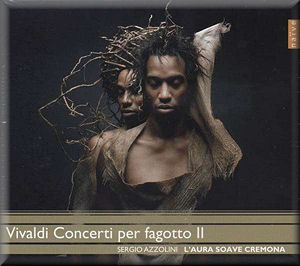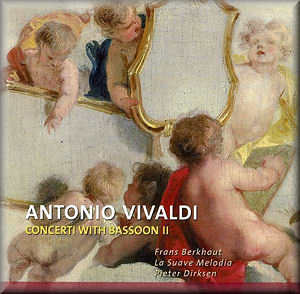 |
 |
|


alternatively
CD: AmazonUK
AmazonUS
Sound
Samples & Downloads |
Antonio VIVALDI (1678 -
1741)
Concerti per fagotto II
Concerto for bassoon, strings and bc in a minor (RV 499) [9:19]
Concerto for bassoon, strings and bc in C (RV 472) [11:20]
Concerto for bassoon, strings and bc in F (RV 490) [11:20]
Concerto for bassoon, strings and bc in g minor (RV 496) [11:49]
Concerto for bassoon, strings and bc in B flat (RV 504) [12:36]
Concerto for bassoon, strings and bc in E flat (RV 483) [8:07]
Concerto for bassoon, strings and bc in C (RV 470) [12:11]
 Sergio Azzolini (bassoon); L'Aura Soave Cremona/Diego Cantalupi
Sergio Azzolini (bassoon); L'Aura Soave Cremona/Diego Cantalupi
rec. April 2011, Church of the Madonna della Formigola, Corticelle
Pieve, Brescia, Italy. DDD
 NAÏVE OP 30518 [76:47]
NAÏVE OP 30518 [76:47]
|
|


alternatively
CD: MDT
AmazonUK
AmazonUS
Sound
Samples & Downloads
|
Antonio VIVALDI
(1678 - 1741) Concerti with bassoon II
Concerto for two cellos [bassoon, cello], strings and bc in g minor
(RV 531) [9:37]
Concerto for bassoon, strings and bc in B flat 'La Notte' (RV 501)
[9:23]
Concerto for bassoon, strings and bc in a minor (RV 498) [10:25]
Concerto da camera for transverse flute, violin, bassoon and bc in
g minor (RV 106) [8:26]
Concerto for bassoon, strings and bc in c minor (RV 480) [9:56]
Concerto for oboe [transverse flute], bassoon, strings and bc in G
(RV 545) [10:45]
Concerto for bassoon, strings and bc in g minor (RV 496) [9:44]
Concerto for two violins, strings and bc in a minor, op. 3,8 (RV 522):
larghetto (arr for violin solo, bassoon, violin, viola and bc) [3:25]
 Frans
Robert Berkhout (bassoon), Georgia Browne (transverse flute), Franc
Polman (violin), Cassandra Luckhardt (cello); La Suave Melodia/Pieter
Dirksen Frans
Robert Berkhout (bassoon), Georgia Browne (transverse flute), Franc
Polman (violin), Cassandra Luckhardt (cello); La Suave Melodia/Pieter
Dirksen
rec. 24 - 25 September 2010, 5 - 6 January 2011, Waalse Kerk, Amsterdam,
Netherlands. DDD
 ET'CETERA KTC 1428 [71:46]
ET'CETERA KTC 1428 [71:46] |
| |
Considering the small number of solo concertos for the bassoon
from the baroque period the number of Vivaldi's compositions
for this instrument is remarkable. With 39 concertos for one
bassoon this part of his oeuvre is the second largest of his
instrumental output, after the concertos for violin. That is
all the more notable as there is no conclusive evidence that
this instrument was played at the Ospedale della PietÓ. Vivaldi
wrote the largest part of his instrumental works for the girls
of this institution.
Vivaldi scholar Michael Talbot, in his liner-notes to the Azzolini
recording, points out that the bassoon concertos all date from
the later part of Vivaldi's career. At that time he was in close
contact with musical institutions outside Italy, in particular
in Germany and Bohemia. He assumes that a number of bassoon
concertos could have been written for Anton M÷ser, the bassoonist
of the court orchestra of Count Morzin, to whom Vivaldi also
dedicated his opus 8 concertos. This suggestion is supported
by the fact that several other members of the orchestra also
composed bassoon concertos which show Vivaldi's influence. Moreover,
as Pieter Dirksen writes in his own liner-notes, the concertos
are all preserved in a single manuscript, which "strongly
suggests a single aristocratic recipient, considering that such
a large group of concertos would have cost a small fortune".
As far as we know the composer didn't play the bassoon himself.
Even so, he must have had a detailed knowledge of the characteristics
and capabilities of the instrument, as his writing is highly
idiomatic and he uses the technical possibilities to the full.
That is combined with his usual preference for theatrical writing,
as comes to the fore in almost all instrumental works from his
pen. That said, several concertos on the disc which Sergio Azzolini
has recorded, show a more than average level of dramatic activity.
Talbot specifically points out the connection to opera of the
Concerto in E flat (RV 483): the first movement shares
its opening with an aria in the opera Semiramide, and
in the second movement he sees an operatic arioso. The Concerto
in B flat (RV 504) also springs to mind: in the first movement
the strings open the procedings, but immediately the bassoon
boldly intervenes with a descending figure which returns at
several moments. The closing allegro also shows a particular
theatrical character.
The concertos are very different in form, for instance in regard
to the role of the strings. In some movements they only play
the ritornellos whereas they keep silent during the solo episodes.
In the Concerto in F (RV 490) they mostly continue
to play during the bassoon solos. On the other hand, several
concertos have a slow movement, in which the bassoon is only
accompanied by the basso continuo.
Sergio Azzolini is one of today's most prominent and brilliant
players of the baroque bassoon. He has unearthed and recorded
various otherwise unknown pieces, both solo concertos and sonatas,
by Italian and German composers. In the ensemble L'Aura Soave
Cremona he has found congenial partners. They share his preference
for extroverted and theatrical interpretations, in which the
contrasts in Vivaldi's compositions are fully explored. Sometimes
they move to the limits of good taste. In some cases I would
have preferred a more subtle approach, as in the opening movement
of the Concerto in a minor (RV 499). Azzolini here
impresses by his sensible treatment of dynamics. I also would
have preferred a smaller scoring: with three first and three
second violins the ensemble produces a strong sound which I
sometimes find a bit too noisy. Even so, there can be no doubt
that this recording is highly captivating: there is really no
chance of falling asleep while these artists are playing.
Frans Robert Berkhout and the ensemble La Suave Melodia expand
the horizon of Vivaldi's writing for the bassoon. In addition
to the solo concertos there are various concertos for multiple
instruments which include the bassoon, one double concerto as
well as concerti da camera with a solo part for the
bassoon.
The Concerto da camera in g minor (RV 106) is an example
of a genre to which Vivaldi contributed some of his most brilliant
and evocative works. In these pieces he combined the scoring
of the sonata - three or four solo instruments and basso continuo
- with the structure of the solo concerto, comprising three
movements: fast - slow - fast. Several of these pieces were
later reworked as solo concertos with ripieno strings. One of
the most famous concerti da camera is the one in
g minor (RV 104), with the nickname La Notte.
On this disc we find Vivaldi's later reworking as the Concerto
in B flat (RV 501). In this form it has lost nothing of
its evocative character, and Frans Robert Berkhout and his colleagues
deliver a highly compelling performance.
Vivaldi wrote just one double concerto with a bassoon part,
the Concerto in G (RV 545). Originally the first solo
part was intended for the recorder, but later Vivaldi decided
to give it to the oboe. Here this part is performed on the transverse
flute, because Pieter Dirksen believes Vivaldi may have had
this instrument in mind. He refers to the fact that the range
of this part never transcends the tessitura of the flute. The
Concerto in g minor (RV 531) is also played here in
a different scoring. Originally it was a double concerto for
two cellos, but here the first part is scored for the bassoon,
which required "a few minor changes". Whatever one
may think about the reasoning of such adaptations, this was
a widespread practice in the baroque era. Therefore there is
no serious objection against this procedure as long as it is
tasteful and according to the style of the period; that is certainly
the case here.
Whereas many of Vivaldi's concertos are highly theatrical, Vivaldi
knew very well that the bassoon is able to produce lyricism
as well. A most impressive example is the Concerto in a
minor (RV 498), whose character is strongly influenced
by the low pitch of the string ritornellos. The solo part in
the first movement is dominated by descending figures. Berkhout
and La Suave Melodia play this concerto with great sensitivity
and subtlety. In the closing movement of the Concerto in
c minor (RV 480) they show that they can let loose too.
The performances in these two recordings are quite different.
Only one piece appears on both discs: the Concerto in g
minor (RV 496). The interpretation of Sergio Azzolini and
L'Aura Soave Cremona is more theatrical and extroverted, with
greater dynamic contrast, and a middle movement which is taken
at a very slow speed. Frans Robert Berkhout and La Suave Melodia
take a more restrained approach, which also works quite well.
Here the rhythms of the fast movements are particularly well
exposed, more so than in Azzolini's recording. The difference
between the two recordings is also due to the smaller line-up
of La Suave Melodia: just three violins versus the six of the
Italian ensemble. In addition, the acoustic circumstances create
a more intimate atmosphere.
Whatever the differences, I have enjoyed both recordings and
would not to choose between them. Which of these two one prefers
is probably largely a matter of taste. The Vivaldi Edition is
aiming at recording the complete oeuvre of Vivaldi, so we can
be sure that more discs with bassoon concertos will appear.
The Et'cetera disc is the second from Berkhout; I
reviewed the first elsewhere. I don't know whether he also
plans to record all of Vivaldi's works for bassoon. I certainly
hope so, as I have enjoyed this disc, just as I did the first
volume.
Every lover of Vivaldi's music and any bassoon aficionado will
be very pleased with these two discs.
Johan van Veen
http://www.musica-dei-donum.org
https://twitter.com/johanvanveen
|
|

